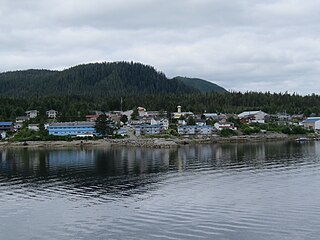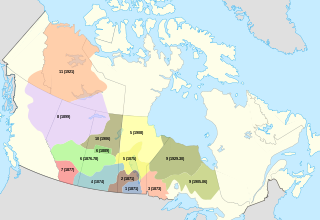
R v Big M Drug Mart Ltd is a landmark decision by Supreme Court of Canada where the Court struck down the Lord's Day Act for violating section 2 of the Canadian Charter of Rights and Freedoms. This case had many firsts in constitutional law including being the first to interpret section 2.

Bella Bella, also known as Waglisla, is the home of the Heiltsuk and is an unincorporated community and Indian Reserve community located within Bella Bella Indian Reserve No. 1 on the east coast of Campbell Island in the Central Coast region of British Columbia, Canada. Bella Bella is located 98 nautical miles (181 km) north of Port Hardy, on Vancouver Island, and 78 nautical miles (144 km) west of Bella Coola. The community is on Lama Passage, part of the Inside Passage – a transportation route linking the area, and northern British Columbia as well as Alaska for marine vessels carrying cargo, passengers and recreational boaters from the south coast.

Corbiere v Canada [1999] 2 S.C.R. 203, is a leading case from the Supreme Court of Canada where the Court expanded the scope of applicable grounds upon which a section 15(1) Charter claim can be based. This was also the first case to use the framework proposed by Law v. Canada.

R v Sparrow, [1990] 1 S.C.R. 1075 was an important decision of the Supreme Court of Canada concerning the application of Aboriginal rights under section 35(1) of the Constitution Act, 1982. The Court held that Aboriginal rights, such as fishing, that were in existence in 1982 are protected under the Constitution of Canada and cannot be infringed without justification on account of the government's fiduciary duty to the Aboriginal peoples of Canada.
Section 35 of the Constitution Act, 1982 provides constitutional protection to the indigenous and treaty rights of indigenous peoples in Canada. The section, while within the Constitution of Canada, falls outside the Canadian Charter of Rights and Freedoms. The section does not define the term "aboriginal rights" or provide a closed list; some examples of the rights that section 35 has been found to protect are fishing, logging, hunting, the right to land and the right to enforcement of treaties. There remains a debate over whether the right to indigenous self-government is included within section 35. As of 2006 the Supreme Court of Canada has made no ruling on the matter. However, since 1995 the Government of Canada has had a policy recognizing the inherent right of self-government under section 35.

Delgamuukw v British Columbia, [1997] 3 SCR 1010, also known as Delgamuukw v The Queen, is a ruling by the Supreme Court of Canada that contains its first comprehensive account of Aboriginal title in Canada. The Gitxsan and Wet'suwet'en peoples claimed Aboriginal title and jurisdiction over 58,000 square kilometres in northwest British Columbia. The plaintiffs lost the case at trial, but the Supreme Court of Canada ordered a new trial because of deficiencies relating to the pleadings and treatment of evidence. In this decision, the Court went on to describe the "nature and scope" of the protection given to Aboriginal title under section 35 of the Constitution Act, 1982, defined how a claimant can prove Aboriginal title, and clarified how the justification test from R v Sparrow applies when Aboriginal title is infringed. The decision is also important for its treatment of oral testimony as evidence of historic occupation.
Section 25 of the Canadian Charter of Rights and Freedoms is the first section under the heading "General" in the Charter, and like other sections within the "General" sphere, it aids in the interpretation of rights elsewhere in the Charter. While section 25 is also the Charter section that deals most directly with Aboriginal peoples in Canada, it does not create or constitutionalize rights for them.

The Heiltsuk Nation is a First Nations government in the Central Coast region of the Canadian province of British Columbia, centred on Campbell Island in the community of Bella Bella, British Columbia. The Heiltsuk people speak the Heiltsuk language, and were, like their language, and along with the neighbouring Haisla and Wuikinuxv (Owekeeno) peoples, incorrectly known in the past as the "Northern Kwakiutl". The Heiltsuk were also known as the Bella Bella, after their core community.

R v Marshall; R v Bernard 2005 SCC 43 is a leading Aboriginal rights decision of the Supreme Court of Canada where the Court narrowed the test from R. v. Marshall for determining the extent of constitutional protection upon Aboriginal practices. The Court held that there was no right to commercial logging granted in the "Peace and Friendship treaties of 1760", the same set of treaties where the right to commercial fishing was granted in the R. v. Marshall decision. This decision also applied and developed the test for aboriginal title from Delgamuukw v British Columbia.

R v Pamajewon, [1996] 2 S.C.R. 821, is a leading Supreme Court of Canada decision on Aboriginal self-government under section 35(1) of the Constitution Act, 1982. The Court held that the right to self-government, if it exists, is subject to reasonable limitations and excluded the right to control high-stakes gambling.

Mitchell v MNR, [2001] 1 S.C.R. 911 is a leading Supreme Court of Canada decision on aboriginal rights under section 35(1) of the Constitution Act, 1982. The court held that Mitchell's claim to an aboriginal right to import goods across the Canada–US border was invalid as he was unable to present enough evidence showing that the importation was an integral part of the band's distinctive culture.

R v Badger, [1996] 1 S.C.R. 771 is a leading Supreme Court of Canada decision on the scope of aboriginal treaty rights. The Court set out a number of principles regarding the interpretation of treaties between the Crown and aboriginal peoples in Canada.

Kruger v R, [1978] 1 S.C.R. 104, was a decision by the Supreme Court of Canada on the relationship between the Indian Act and provincial game laws. The Indian Act is a federal law enacted under the British North America Act, 1867, which gives jurisdiction over Aboriginals to the federal government. The Court found that the Indian Act's statement that provincial laws may apply to Aboriginal peoples in Canada as long as they apply to other people protects laws even if these laws affect Aboriginals more than others.
R. v. Jim (1915) 26 C.C.C. 236, was a decision by the British Columbia Supreme Court on Aboriginal ("Indian") hunting and provincial game laws. The Court found that Aboriginal hunting on Indian reserves is primarily federal jurisdiction, relating to section 91(24) of the British North America Act, 1867 which assigns "Indians, and Lands reserved for the Indians" to the federal government.

Aboriginal title is a common law doctrine that the land rights of indigenous peoples to customary tenure persist after the assumption of sovereignty under settler colonialism. The requirements of proof for the recognition of aboriginal title, the content of aboriginal title, the methods of extinguishing aboriginal title, and the availability of compensation in the case of extinguishment vary significantly by jurisdiction. Nearly all jurisdictions are in agreement that aboriginal title is inalienable, and that it may be held either individually or collectively.
R v Marshall [1999] 3 S.C.R. 456 and R v Marshall [1999] 3 S.C.R. 533 are two decisions given by the Supreme Court of Canada on a single case regarding a treaty right to fish.
R. v. Gonzales (1962), 37 C.R. 56, was a landmark decision by the British Columbia Court of Appeal holding that Section 94(a) of the Indian Act did not violate the respondent's equality before the law, guaranteed under section 1(b) of the Canadian Bill of Rights, because all Indians were treated in the same way. Gonzales is particularly famous for employing the similarly situated test, which was not used in R. v. Drybones and was explicitly rejected by the Supreme Court of Canada in Andrews v. Law Society of British Columbia.
R. v. Powley 2003 SCC 43, commonly called the Powley ruling, is a Supreme Court of Canada case defining Métis Aboriginal rights under section 35(1) of the Constitution Act, 1982.
The Anishinaabe Nation in Treaty No. 3 is a sovereign Anishinaabe Nation in Canada. It has existed as a self-governing people with its own laws and governance institutions since time immemorial, before the arrival of European settlers. "America, separated from Europe by a wide ocean, was inhabited by ... separate nations, independent of each other and of the rest of the world, having institutions of their own, and governing themselves by their own laws." "The territory included in Treaty #3 in 1873 was governed by a Grand Council of Anishinaabe Chiefs. ... This civil leadership was responsible to other political ranks and ultimately to the constituent families." The Nation is, by constitutional definition, the Anishinaabe people that entered into Treaty 3 with the Crown in 1873.









